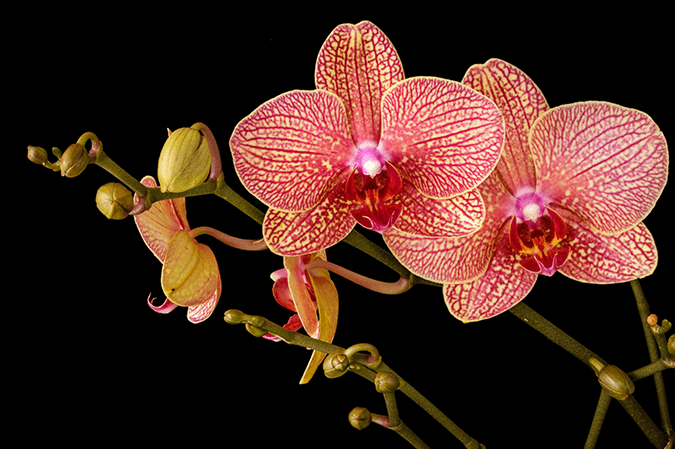Description
Orchids are one of the most prominent families of flowering plants, known scientifically as Orchidaceae. With over 25,000 species and 100,000 hybrids, orchids are highly diverse and can be found on every continent except Antarctica. These plants are known for their unique, intricate flowers, which vary significantly in size, shape, and color. Orchids can grow in various environments, including tropical forests, grasslands, and even arid regions.
- Flower Structure: Orchids are characterized by their complex flower structures, which typically consist of three sepals and three petals, one of which forms a distinctive lip (labellum) that often serves as a landing platform for pollinators.
- Variety: Some popular types of orchids include Phalaenopsis (moth orchids), Cattleya (corsage orchids), Dendrobium, and Vanda.
Common Features
- Epiphytic Nature: Many orchids are epiphytes, meaning they grow on other plants or trees without drawing nutrients from their host. They absorb water and nutrients from the air, rain, and debris that collects around them.
- Aerial Roots: Orchids often have thick, fleshy roots that help them cling to surfaces and absorb moisture and nutrients from the air.
- Longevity: Orchids are perennial plants, with some species living under the right conditions for decades.
- Leaf Structure: Orchid leaves are generally thick and leathery, designed to store water in periods of drought.
Role in the Ecosystem
- Pollination: Orchids play a vital role in the ecosystem by supporting many pollinators, including bees, moths, butterflies, and birds. Many orchids have evolved highly specialized relationships with their pollinators, ensuring their survival and reproduction.
- Biodiversity: By providing habitats for various organisms, orchids contribute to the biodiversity of the regions in which they grow. Their presence in ecosystems can indicate a healthy environment.
- Symbiosis: Orchids often form symbiotic relationships with mycorrhizal fungi, which help them obtain nutrients from the soil. This relationship is essential for germinating orchid seeds, which lack sufficient food reserves.
Importance
- Horticultural Value: Orchids are highly prized in horticulture for their stunning and diverse flowers. They are one of the most popular plants for collectors and are a significant part of the global floral trade.
- Cultural Significance: Orchids are important in many societies. They are a symbol of beauty and refinement in many Asian cultures and are used in traditional medicines.
- Economic Importance: Orchids are economically significant in the floriculture industry, where they are cultivated and sold as ornamental plants and cut flowers.
- Environmental Indicators: Orchids are often used as indicators of environmental health due to their sensitivity to changes in their habitat, particularly in terms of climate and pollution levels.
Interesting Facts
- Vanilla: The vanilla flavoring comes from the seed pods of the Vanilla planifolia orchid, making it one of the few orchids commercially cultivated for purposes other than ornamental use.
- Adaptability: Orchids can grow in various environments, from tropical rainforests to alpine regions, demonstrating remarkable adaptability.
- Diversity: Orchids display incredible diversity in form and function, with some species mimicking the appearance and scent of female insects to attract pollinators.



